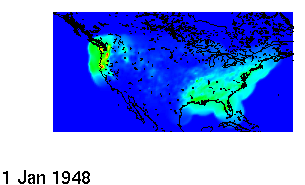
| - | CPC_.25x.25_Daily_US_UNIFIED_Precipitation Monthly Accumulated Precipitation
From this top THREDDS page, five clicks (Public Climate Data from the
NOAA-CIRES Climate Diagnostics
Center,
CPC .25x.25 Daily US UNIFIED Precipitation,
Monthly Accumulated Precipitation (twice),
and This involves the cooperation of a number of servers and software. In addition to the Ingrid server (and her proxy server squid), there is motherlode.ucar.edu:8080 for the THREDDS top, www.cdc.noaa.gov for its THREDDS catalog, www.cdc.noaa.gov/dodsC AggServer, for the DODS dataset, and the underlying DODS server the AggServer was talking to get the individual datasets. |
|---|---|---|
| Current NCEP Eta Model Runs | - | a few days worth of twelve-hourly forecast runs distributed
through IDD, in this case via a DODS server at UCAR. In this case the
client has analyzed the pattern in the dataset names to generate a
two-dimensional table to present the dataset choices, i.e. it is
strictly based on the information in the THREDDS xml document.
Clicking on a
Below that is a view of the current variable absolute vorticity at record 1 and 1000 hectopascals, below that the controls to change the slice (independent variables) or (dependent) variable plotted. The viewer is bit lacking for this particular dataset: the dataset was apparently translated into netcdf from a GRIB file, and the only indication of lat/long is buried in the GRIB/projection parameters in the metadata which we do not yet handle. But it is a start. |

| - | Reyn_SmithOIv2 weekly Sea Surface Temperature Anomaly This is a variable from one of the datasets available from the IRI Data Library (click on the image to get to the viewer), downloaded (from itsself) using THREDDS and DODS/OpenDAP. It starts at the top THREDDS node, chooses the IRI Data Library, and then follows the structure presented in the IRI's tree of THREDDS xml files. Once we get to this viewer level, the dataset looks and behaves very much like the dataset as served from the original server. And this is what one would see on any IRI Data Library mirror site, i.e. Ingrid set up to mirror the Data Library contents at iridl.ldeo.columbia.edu. |